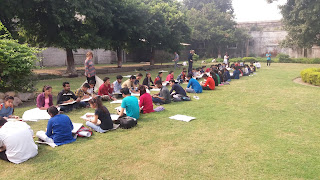I have been spending the last few weekend mornings
at the upper Ganges canal. There is a temple and small ghats where
the delhi road crosses the 30 metre or so span of the river, just a
short rickshaw ride from Modinagar. The ceremonial bathing happens
early in the morning, we saw it once from a taxi, the crowd on the
shore up to their waists in the milky water, floating torsos in the
smoggy morning atmosphere. I have arrived most days after this
ceremony. Priests are in a screened section of the ghats performing
small rituals around a fire and scattered incense, flowers and silver
bowls of food. Offerings drift by on the current, flotillas of orange
marigolds amongst the ubiquitous plastic, crisp packets and
polystyrene thali trays. Young boys wade waist deep against the
strong undertow, trawling heavy weights somewhere down there through
the aquatic soup of silt and debris. The weights are heavy magnets
some from old speakers, cone still attached, used this way for
collecting coins thrown to the sacred river. The boys return to check
their haul on a scrappy spit off the ghats, which is also scattered
with clay vessels and figurines. A man in a black shirt watches over
the boys, taking anything they find.
I notice this hold on people another time, when drawing a place outside a temple where there is a loose gathering of street children, women and, mixed in with the elderly huddle, some Sahdus: religious ascetics who have renounced the worldly life. Several cars pull up in the time I am there, people get out and serve up dahl from takeaway containers and pedestrians too, hand out notes and coins as they leave the ghats. There is a man from the temple, whose orders these dependants obey. He is mid forties; tall, thin, wearing neatly cropped hair, crisp white pyjamas, a single dot of colour on his brow, always stands upright and straight although he clasps his hands so tightly when he talks that he makes them bent and twisted. Everyone in the ragged gathering does this man's bidding and he is their agent, seemingly ready to sell what ever he thinks they have to offer in service. In his presence is a young woman holding a new born who had previously been laughing at my drawing, at me, the children and all the jokes I will never understand. Now with this man, her natural laughter is replaced with a fake complicity as she is offered up to the rich westerner for sex. The holy man inserts his fore finger into the O of his pinched thumb and index to make clear his proposition.
Oblivious perhaps, to the future around them, the
children at the top of the ghats are full of joy and excitement about
being drawn. Occasionally they are scattered by a muttering old
woman, a real character with a chunky stick and glasses pinched to
the end of her nose, but always they sneak back giggling. The
smallest one with the biggest grin will put both his thumbs up in a
positive question directed at me; is it all clear? The grouch has
fallen back to sleep. His quick wit beyond his age reminds me of F
back at home; starting primary school, living care free in a present
tense world explored with a sharp and enquiring mind. This grinning
boy bare foot on the riverside, understands that same joyful
existence. For this precious moment they are in common, a brief
moment, their lives already moving on very different
trajectories.
In uptown Modinagar, there is a small river so
clogged with waste that much of it has silted up and overgrown. On
the left of the road bridge there is a pipe big enough to crawl
through, discharging black water with the stench of sewage. Just
below is a floating mat of plastic waste stretching from bank to
bank, backed up against the silted over riverbed. Upstream the damned
water forms a pool; still and black in colour but cloudy like milk.
The greasy surface reflects ochre and red, the reverent colours of a
Hindu temple on the opposite bank. An unnatural iridescent sheen
glistens purple along the shallow fringes. Swimming pigs bulldoze
through the plastic raft, lost in a hearty enthusiasm for their work.
Their dedication looks absurd, their movement jerky and possessed
like puppetry, snout tossing shoes and tennis balls and plastic hats
up from the discarded depths. Egrets balance on the hog's backs and a
dancing procession of these avian stilt-walkers follows each ones
wake, ready to pounce on smaller prey in a flurry. Yesterday, six
boys put the egrets up in a cloud of white powder as they clambered
onto the rotting mat. Reaching the waterline the boys stripped bare,
sunk themselves in and began to rummage in the fowl water for any
residue of value left discarded.
 |
Trawling for coins
|
































